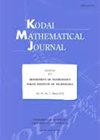Steenrod operations on the modular invariants
IF 0.5
4区 数学
Q4 MATHEMATICS
引用次数: 8
Abstract
In this paper, we compute the action of the mod p Steenrod operations on the modular invariants of the linear groups with p an odd prime number. Introduction Fix an odd prime p. Let Apn be the alternating group on p letters. Denote by Σpn,p a Sylow p-subgroup of Apn and E an elementary abelian p-group of rank n. Then we have the restriction homomorphisms Res(E, Σpn,p) : H (BΣpn,p) −→ H (BE), Res(E, Apn) : H (BApn ) −→ H (BE), induced by the regular permutation representation E ⊂ Σpn,p ⊂ Apn of E (see Mùi [4]). Here and throughout the paper, we assume that the coefficients are taken in the prime field Z/p. Using modular invariant theory of linear groups, Mùi proved in [3, 4] that ImRes(E, Σpn,p) = E(U1, . . . , Un) ⊗ P (V1, . . . , Vn), ImRes(E, Apn ) = E(M̃n,0, . . . , M̃n,n−1) ⊗ P (L̃n, Qn,1, . . . , Qn,n−1), Here and in what follows, E(., . . . , .) and P (., . . . , .) are the exterior and polynomial algebras over Z/p generated by the variables indicated. L̃n, Q,s are the Dickson invariants of dimensions p, 2(p − p), and M̃n,s, , Uk, Vk are the Mùi invariants of dimensions p − 2p, pk−1, 2pk−1 respectively (see Section 1). Let A be the mod p Steenrod algebra and let τs, ξi be the Milnor elements of dimensions 2p − 1, 2p − 2 respectively in the dual algebra A∗ of A. In [7], Milnor showed that, as an algebra A∗ = E(τ0, τ1, . . .) ⊗ P (ξ1, ξ2, . . .). Then A∗ has a basis consisting of all monomials τSξ = τs0 . . . τsk ξ r1 . . . ξm , with S = (s1, . . . , sk), 0 6 s1 < . . . < sk, R = (r1, . . . , rm), ri > 0. Let St ∈ A denote the dual of τSξ with respect to that basis. Then A has a basis consisting all operations St. For S = ∅, R = (r), St∅,(r) is nothing but the Steenrod operation P . Since H(BG), G = E, Σpn,p or Apn , is an A-module (see [13, Chap. VI]) and the restriction homomorphisms are A-linear, their images are A-submodules of H(BE). 2010 Mathematics Subject Classification. Primary 55S10; Secondary 55S05.模不变量上的Steenrod运算
在本文中,我们计算了模p-Steenrod运算对p为奇素数的线性群的模不变量的作用。修正一个奇数素数p。让Apn是p字母上的交替组。用∑pn,p表示Apn的Sylow p-子群,E表示秩n的初等阿贝尔p-群。然后我们得到了限制同态Res(E,∑pn,p):H(B∑pn,p-)−→ H(BE),Res(E,Apn):H(BApn)−→ H(BE),由E的正则置换表示E⊂∑pn,p \8834 Apn诱导(参见Múi[4])。在这里和整个论文中,我们假设系数取在素数域Z/p中。利用线性群的模不变量理论,Múi在[3,4]中证明了ImRes(E,∑pn,p)=E(U1,…,Un)⊗p(V1,…,Vn),ImRes指示。L、Q、s分别是维度p、2(p−p)的Dickson不变量,M、n、s、Uk、Vk分别是维度p−2p、pk−1、2pk−1的Múi不变量(见第1节)。设A是模p Steenrod代数,设τs,ξi分别是A的对偶代数A*中维数为2p−1,2p−2的Milnor元素。在[7]中,Milnor证明了,作为代数A*=E(τ0,τ1,…)⊗p(ξ1,ξ2,…)。则A*具有由所有单项式τsξ=τs0…组成的基。τskξr1。ξm,其中S=(s1,…,sk),0 6 s1<…0。设St∈A表示τSξ相对于该基的对偶。则A有一个由所有运算组成的基。对于S=∅,R=(R),St∅,(R)只不过是Steenrod运算P。由于H(BG),G=E,∑pn,p或Apn是A-模(见[13,第六章]),并且限制同态是A-线性的,因此它们的像是H(BE)的A-子模。2010年数学学科分类。小学55S10;二级55S05。
本文章由计算机程序翻译,如有差异,请以英文原文为准。
求助全文
约1分钟内获得全文
求助全文
来源期刊
CiteScore
0.90
自引率
0.00%
发文量
16
审稿时长
>12 weeks
期刊介绍:
Kodai Mathematical Journal is edited by the Department of Mathematics, Tokyo Institute of Technology. The journal was issued from 1949 until 1977 as Kodai Mathematical Seminar Reports, and was renewed in 1978 under the present name. The journal is published three times yearly and includes original papers in mathematics.

 求助内容:
求助内容: 应助结果提醒方式:
应助结果提醒方式:


